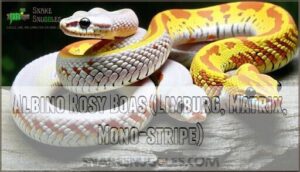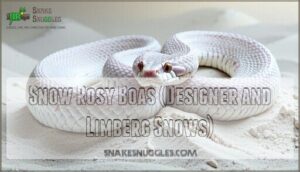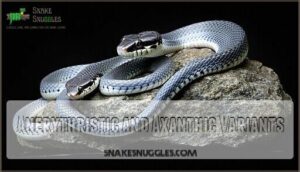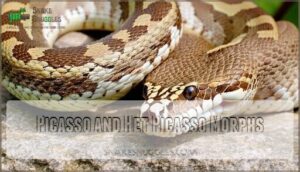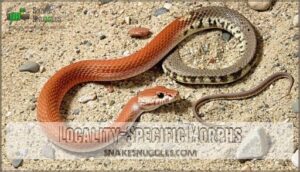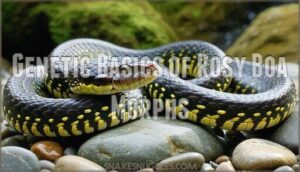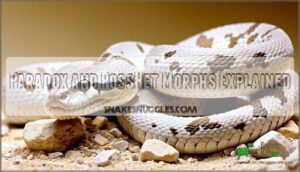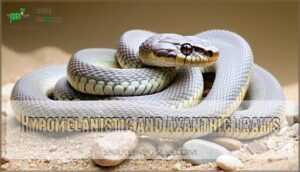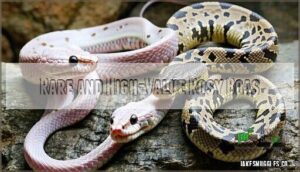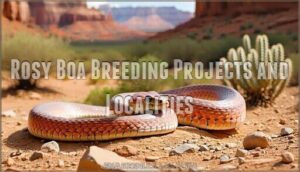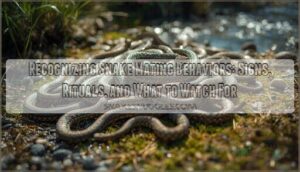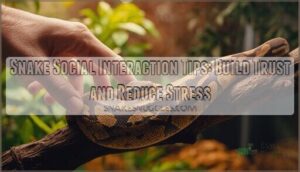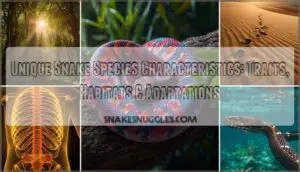This site is supported by our readers. We may earn a commission, at no cost to you, if you purchase through links.
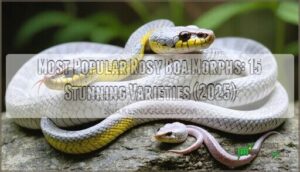
Albino morphs showcase T-negative genetics that eliminate melanin completely, while snow combinations can fetch $1,250 each. Picasso morphs represent the holy grail at $1,500, thanks to their remarkable genetic complexity.
Axanthic varieties bring something different to the table—their blue-gray tones create striking contrast that collectors love. Paradox morphs throw curveballs with unexpected color patches that shouldn’t exist according to genetics textbooks. Both offer serious Het potential for ambitious breeding projects. Success comes down to spotting which recessive combinations deliver the biggest visual punch while opening doors for future generations.
Table Of Contents
- Key Takeaways
- Most Sought-After Rosy Boa Morphs
- Unique Color Patterns and Genetics
- Rare and High-Value Rosy Boas
- Rosy Boa Breeding Projects and Localities
- Care Requirements for Morphs
- Frequently Asked Questions (FAQs)
- What is the average size of a Mexican Rosy Boa?
- How did the Albino Rosy Boa get its unique coloration?
- What is the rarity level of the Anerythristic Rosy Boa?
- What temperatures do rosy boa morphs need?
- How often should morphs be handled safely?
- Which morphs are easiest for beginners?
- Do different morphs have varying lifespans?
- What signs indicate morph breeding readiness?
- Conclusion
Key Takeaways
- You’ll find albino varieties (Limburg, Matrix, Mono-stripe) dominating the market, with over 80% selling within six months and commanding $400-$900 each due to their striking amelanistic traits and proven T-negative genetics.
- Snow morphs and Picasso variants represent the premium tier, with designer snows fetching $1,250 and rare Picassos reaching $1,500 thanks to their complex genetic combinations and visual appeal.
- You can maximize breeding potential by understanding recessive inheritance patterns—axanthic, anerythristic, and paradox morphs offer exciting Het possibilities for multi-gene projects.
- Market demand consistently favors morphs with verified genetics and clear lineage over posshet animals, making documented breeding records essential for commanding top prices in today’s competitive morph market.
Most Sought-After Rosy Boa Morphs
You’ll find that albino rosy boas consistently rank among the top three most sought-after morphs, with over 80% selling within six months due to their striking amelanistic traits and proven genetics.
Snow morphs and anerythristic variants aren’t far behind in popularity. These morphs command premium prices because collectors recognize both their visual appeal and their value for breeding projects in today’s competitive market.
Albino Rosy Boas (Limburg, Matrix, Mono-stripe)
When you’re diving into albino genetics, these three morphs stand out as breeding goldmines. Limburg variations showcase stunning cream-and-orange patterns that’ll make your collection pop. Matrix patterns display intricate geometric designs across their scales, while monostripe traits create clean, single-line patterns.
Breeding albinos requires understanding T-negative genetics—these snakes lack melanin completely, producing those jaw-dropping colors collectors crave.
Snow Rosy Boas (Designer and Limberg Snows)
When you mix albinism with axanthism, you get Snow genetics – and the results are absolutely stunning. These white boas still show their subtle patterns, just muted and elegant.
You’ll find cool designer versions too, like Carlson Snows and Snowwhites, each tracing back to different Limberg lines with their own distinct look.
These Designer Rosy Boas command premium prices around $1,250 due to their jaw-dropping rarity. Rosy Boa Morphs don’t get much more stunning than these genetic masterpieces.
Anerythristic and Axanthic Variants
Collectors go wild for anerythristic and axanthic variants – these morphs ditch the usual warm colors for dramatic black-and-white patterns.
Sure, they’re trickier to breed, but the payoff is worth it when you see those bold color contrasts.
- Blue Borrego Anery – displays stunning silver-blue tones with crisp black stripes
- Morongo Axanthic – features pure grayscale patterns without yellow pigmentation
- Anery poshet Snow combinations – create complex genetic combinations for future projects
These Rosy Boa morphs command premium prices due to their rarity and distinctive axanthic patterns that eliminate warm tones completely.
Picasso and Het Picasso Morphs
You’ll recognize Picasso morphs by their distinctive broken stripe patterns that resemble abstract art. These striking snake morphs command premium prices around $1,500 due to their rarity and visual appeal.
Het Picasso individuals carry the recessive gene without showing visual traits, making Het identification important for breeding potential.
Picassos showcase unpredictable pattern disruptions that make each rosy boa unique, explaining their growing morph popularity among collectors.
Locality-Specific Morphs
Locality-Specific Morphs preserve Geographic Variations found in wild populations. Whitewater Rosy Boa and Harquahala Rosy Boa represent Specific Localities with distinct traits.
Breeders prioritize Locality Pure lines to maintain Genetic Diversity through Conservation Efforts.
These Rosy Boa Localities offer authentic regional characteristics, making Morph Identification easier while supporting natural Rosy Boa Morphs preservation.
Unique Color Patterns and Genetics
Rosy boa genetics work through straightforward recessive and co-dominant inheritance patterns. Albino, axanthic, and paradox traits mix and match to produce eye-catching designer morphs that keep breeders coming back for more.
If you’re diving into complex multi-gene projects like hypocabazaxanthic or snow morphs, you’ll need to get comfortable with het (heterozygous) and poshet (possible heterozygous) genetics.
Genetic Basics of Rosy Boa Morphs
Understanding rosy boa genetics unlocks the secrets behind these stunning snake color variations. Most rosy boa morphs follow recessive genes patterns, where you’ll need two copies for visible traits. Dominant traits appear with just one gene copy, while co-dominance creates blended effects.
Gene mutations create new morphs through natural genetic variations. Morph inheritance follows predictable patterns, making snake genetics fascinating for breeders seeking specific outcomes.
Rosy boas display a range of colors because of locale-specific designs.
Paradox and PossHet Morphs Explained
Paradox genetics create visual magic in rosy boa morphs through random pigment patches that defy normal inheritance patterns. You’ll spot these genetic mutations as unexpected color bursts on otherwise uniform snakes.
Paradox Albino rosy boas showcase stunning contrast between typical albino areas and darker paradox patches.
PossHet identification requires careful breeding strategies since these rarity factors don’t follow predictable Mendelian inheritance, making each paradox snake a unique treasure.
Hypomelanistic and Axanthic Traits
Hypo genetics create stunning visual variations by reducing dark pigmentation in rosy boa morphs. When you combine hypomelanistic traits with axanthic expression, you get breathtaking double recessive combinations. These genetic mutations showcase remarkable color inheritance patterns.
- Hypo genetics – Reduces melanin production for lighter base colors
- Axanthic expression – Eliminates yellow pigments creating blue-gray tones
- Double recessive – Both parents must carry genes for visual expression
- Color inheritance – Follows predictable Mendelian genetics patterns
- Visual variations – Creates unique snake morphs with reduced pigmentation
Rare and High-Value Rosy Boas
You’ll find rare morph combinations like Snow Rosy Boas commanding premium prices of $1,250 each, while Picasso morphs reach $1,500 due to their remarkable genetic complexity.
Market demand drives values highest for designer combinations involving multiple recessive traits, with collectors actively seeking posHet Albino/Paradox/Axanthic specimens that offer promising breeding potential.
Market Value of Designer Morphs
The rosy boa market is absolutely booming right now. Collectors are going crazy for designer morphs, and honestly, who can blame them? The money potential in genetic mutations is seriously impressive—albino morphs are selling for $400–$900, while those stunning Picasso variants can hit $800–$1,200.
Market swings keep things interesting for smart collectors. Pricing depends heavily on how complex the genetics are, which keeps pushing values up.
Looking ahead, rare snakes with solid genetic documentation are only going to get more valuable. That’s why finding quality stock is becoming so crucial.
Rarity and Availability Trends
Why are some morphs harder to find than others? Morph Demand drives availability patterns, with Snow morphs seeing 6-month sellout rates while common localities sit longer.
Breeding Success varies dramatically between projects, creating Geographic Scarcity in certain lines. Rare Snake Availability fluctuates seasonally, causing Price Fluctuations that reflect market dynamics.
Ethical Sourcing limits supply of wild-caught foundation stock, while Genetic Variation in Boas determines which combinations emerge successfully from Snake Breeding and Genetics programs.
Factors Influencing Morph Prices
What drives rosy boa morph prices? Morph demand sits at the heart of it all. Albino snakes pull in premium prices because collectors love that striking visual appeal.
Breeding costs play a major role too, especially when you’re dealing with complex genetic traits that take multiple generations to perfect.
Market scarcity pushes values even higher. Take Picasso morphs—they’re hitting $1,500+ because so few breeders actually produce them.
Snake morphs with proven genetics and solid lineage will cost you more than posshet animals where the traits remain a question mark.
Rosy Boa Breeding Projects and Localities
Rosy boa breeders typically follow one of two paths: some focus on locality-specific work, keeping bloodlines pure from places like Whitewater and Borrego Desert, while others mix traits from different populations to create entirely new looks—think hypocabazaxanthic combinations that didn’t exist in nature.
Understanding the distinction between these methodologies becomes essential when you’re planning breeding projects, as locality work maintains genetic integrity while designer crosses produce unique morphs like hypocabazaxanthic combinations.
Locality-Specific Breeding Programs
When diving into locality-specific breeding projects, you’re preserving genetic integrity while maintaining conservation efforts that protect wild populations.
Locality pure rosy boa breeding requires careful lineage tracking to document each animal’s geographic origins. These breeding projects focus on maintaining distinct locality traits like Coastal Desert patterns or Mojave colorations.
Hybridization risks increase when mixing localities, potentially diluting unique characteristics that make each population special.
Non-Locality Designer Breeding
Designer breeding breaks free from geographic boundaries, letting you create stunning morph combinations through genetic innovation. You’re not limited to single localities anymore—trait selection from different bloodlines produces hybrid vigor and unique phenotypes.
Modern reptile breeding embraces this creative approach, where snake morphs showcase genetic mutations across multiple rosy boa populations.
- Cross-locality projects combine traits like Limburg albino with Desert locality patterns
- Multi-gene combinations stack axanthic, albino, and paradox traits for complex morphs
- Selective breeding programs focus on specific characteristics rather than geographic origins
Conservation and Genetic Purity
You’re holding the promise of rosy boa genetics in your hands when you prioritize locality pure breeding. Responsible breeding practices protect genetic diversity within subspecies while supporting habitat preservation through conservation efforts.
Genetic variation in boas depends on maintaining locality integrity—mixing populations destroys thousands of years of natural selection.
Rosy boa conservation starts with your commitment to preserving these distinct genetic lineages for future generations.
Care Requirements for Morphs
Morphs require identical husbandry to wild-type rosy boas, with no special genetic-based care modifications needed for albinos, snows, or anerythristic variants.
Axanthic and paradox morphs thrive in standard 40-gallon setups with proper substrate depth and ambient temperatures between 75-85°F.
Proper Enclosure Setup for Morphs
Your rosy boa morph needs proper housing to thrive. Choose a 40-gallon tank minimum for adult snakes, avoiding metal screen tops that cause nose abrasions.
Create a temperature gradient from 75-85°F with quality substrate like cypress mulch for burrowing. Maintain 30-50% humidity levels and provide secure hiding spots on both warm and cool sides of the enclosure.
Feeding and Watering Needs
Getting your rosy boa’s diet right comes down to two main factors: how old they are and their specific genetics. Adult boas do best with prey that matches their thickest body section – think of it as feeding them something roughly as wide as their middle. Most adults need to eat every 10-14 days when they’re active.
- Prey Size: Pick rodents about as thick as your snake’s widest part
- Feeding Frequency: Adults eat every two weeks; younger snakes need weekly meals to grow properly
- Water Bowl: Give them fresh water in bowls big enough for full-body soaks
- Supplementation: Whole prey diets usually cover all their nutritional needs
- Shedding Aid: Bump up humidity near water bowls when they’re getting ready to shed
Health Considerations for Rare Morphs
Genetic mutations can trigger morph-related ailments you’ll need to monitor closely. Visual albino to visual albino pairings sometimes produce deformities, particularly around the eyes.
Breeding ethics demand careful genetic predispositions assessment – husbandry impacts directly affect lifespan variations. Snake genetics research shows some phenotypes carry hidden risks.
Smart rosy boa breeding means choosing captive breeding partners wisely to avoid complications.
Frequently Asked Questions (FAQs)
What is the average size of a Mexican Rosy Boa?
Imagine this: you’re sizing up your future scaly companion. Mexican Rosy Boas usually reach 17-44 inches in total length, making them perfectly manageable serpents for any keeper’s collection.
How did the Albino Rosy Boa get its unique coloration?
You’ll discover that albino rosy boas lack melanin production due to a recessive genetic mutation.
This tyrosinase-deficient condition eliminates dark pigments, revealing stunning yellow, orange, and pink hues with bright red eyes.
What is the rarity level of the Anerythristic Rosy Boa?
Anerythristic rosy boas are moderately rare morphs. You’ll find them priced between $500-$1,900 as hatchlings. Their striking black-and-white coloration makes them highly sought after among collectors.
What temperatures do rosy boa morphs need?
You’ll need temperatures around 80-85°F on warm side and 70-75°F on cool side. Basking spot should hit 90°F. Night temps can drop safely to 60°F.
How often should morphs be handled safely?
Handle your morphs twice weekly at most. Young snakes adapt better to regular, brief sessions. Gentle movements prevent stress while building trust naturally.
Which morphs are easiest for beginners?
Over 60% of new keepers choose locality-specific morphs for their predictable genetics.
You’ll find wild-type Desert and Coastal localities most forgiving—they’re hardy, display consistent patterns, and won’t break your budget while you’re learning proper husbandry techniques.
Do different morphs have varying lifespans?
Morph genetics don’t affect lifespan – you’re looking at the same 20-30 year potential regardless. Albinos, snows, and anerys all live just as long as wild-types when you provide proper care and husbandry.
What signs indicate morph breeding readiness?
Watch for adequate weight gain after brumation, steady feeding responses, and proper size milestones.
Females commonly reach sexual maturity around two years of age, while males can be ready as early as one year.
Conclusion
Think of rosy boa genetics like collecting trading cards—each morph represents a rare find with specific value. The most popular rosy boa morphs you’ve explored showcase nature’s vast genetic diversity, from $1,500 Picassos to stunning snow combinations.
Rosy boa morphs range from common albinos to $1,500 Picasso rarities, each representing a unique genetic treasure in the collector’s world
Whether you’re targeting albino varieties, axanthic specimens, or locality-specific beauties, understanding recessive traits and Het possibilities opens endless breeding opportunities.
These morphs aren’t just pets—they’re living art pieces that combine scientific fascination with visual beauty, making every acquisition a worthwhile investment.

